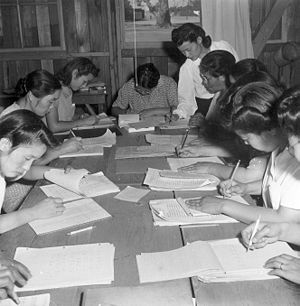 Image via WikipediaJoanne began by offering some background to the one part qualification National Diploma in Journalism; four semesters, part-time. that they wanted to offer that included Teelin shorthand. It is really difficult to describe shorthand with text (there are limited manuals), and there were some real difficulties around offering a manual skill online.
Image via WikipediaJoanne began by offering some background to the one part qualification National Diploma in Journalism; four semesters, part-time. that they wanted to offer that included Teelin shorthand. It is really difficult to describe shorthand with text (there are limited manuals), and there were some real difficulties around offering a manual skill online.However,they used what they had available including tutor notebooks/workbook, and also made a video available of the tutor herself, and used a dictation booklet too.
There was a feeling that the students would be asking “why do we have to do this?” so one of the first things they did was give reasons, There is a strong use of learning outcomes. Multimedia was offered in two forms – either by clicking on a link and the video plays in their browser. In a situation with less bandwidth students could right click and download the video.
The videos covered, for instance, the alphabet for shorthand and around how to form the letters. The video that was shown featured the tutor talking through the alphabet and the formation of the letters. Students can watch the videos as many times as they want.
A number of worksheets were made available, and provided lots of opportunities for practising recognising and writing the different forms. Then the students were offered further scaffolding (e.g. flashcards) and other exercises.
Had real life students for the first time this year, and most already have jobs, hence they are studying online. As a nice side-benefit, students are printing off things such as the flashcards and are finding that the children of the students are learning the shorthand with them because they turn it into a game. There are also online, self-check quizzes that students can complete. There are a lot of .pdf files to download with the idea that they can print off the worksheets if they want to and keep them in a file.
Each week has a video with the tutor introducing the subject / skills, then some practice exercises, followed by worksheets, and then some other exercises such as listening to an audio file as a speed exercise. Written work can be scanned in, or students can take a photo of their work before submitting it to the tutor.
The challenges include 'going solo' and there is a lot of focus on individual work; time is also an issue as is motivation. There are times when the students and teachers meet online and talk things through, and use of the discussion forums is encouraged. The assessment is at the end of the course, and there is no way to stagger the assessments to encourage motivation and give ongoing feedback. The tutor keeps in very regular contact with the students, and checks in with how they are doing. The tutor finds it tricky not being able to ' look over the should' as students' work, and it is more difficult to give timely feedback.
An eLearning team developed the course and the resources, and worked with the tutor who provided the materials. The first students who are going to be assessed is October next year, and it is hoped that an invigilator can be organised (who is also an aspect of another part of the course).
The overall impression is that it is definitely possible to do this, and to increase effectiveness and make more things interactive would require extra budget to, for instance, create flash objects that would assist with forming the letters. It seems to be that conundrum of wanting to offer the flexibility that enables students to choose when, where and how to learn, and yet to also challenge the notion that online learning is cheaper than face-to-face. To be most effective these types of course require investment.






1 comment:
Learning a seemingly boring subject like shorthand can definitely need a little boosting up with elearning games. I think developers of corporate learning solutions should include games and interactivity in their projects.
Post a Comment